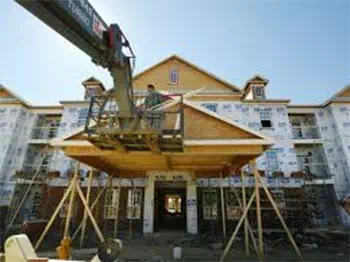Construction Activities
This section of HERC provides an overview of EPA regulations that may impact construction activities at assisted living/nursing home communities. Numerous links are provided to further investigate federal and state regulations and to locate guidance documents and points of contact.
Construction
Many construction projects, including new buildings and parking lots, disturb the surface of land. When precipitation occurs, stormwater runoff from these sites can have a significant impact on water quality by contributing sediment and other pollutants to creeks, streams, lakes, etc. Under the Federal Clean Water Act, EPA's National Pollutant Discharge Elimination System (NPDES) permit program controls water pollution by regulating sources of pollution, including runoff from construction sites. EPA's stormwater program requires construction site operators engaged in clearing, grading, and excavating activities that disturb one acre or more to obtain coverage under an NPDES permit for their stormwater discharges. For more information, see:
- Construction Industry Compliance Assistance Center (detailed regulatory information,
- Stormwater Resource Locator (obtain forms and more information on application procedures and permit requirements for construction projects in your state), and
- EPA's Stormwater Homepage (basic and detailed information and guidance).
If your construction project includes installation of new plumbing fixtures, be aware that a revised EPA standard for "lead free" pipes, plumbing fixtures, plumbing fittings, solder and flux, went into effect in 2014 as a result of the Reduction of Lead in Drinking Water Act. The new rule requires that "lead free" plumbing fixtures be used in public water systems and in plumbing that carries water for human consumption in residential and non-residential facilities. For more information, see:
- Lead Pipes and Plumbing Fixtures, and
- Lead in Drinking Water (EPA over view with links to rules).
Building Renovation
Many renovation projects involve demolition or modification of existing construction. In such cases, you may find existing building materials present that are regulated when they are encountered and/or removed. The most common issues are:
- Asbestos: Asbestos is present in older building materials including
piping insulation and roof shingles. Federal regulations
require the owner of the building or the operator to notify the appropriate state agency before any
demolition, or before any renovations of buildings that could contain a certain threshold amount of
asbestos. For more information see:
- HERC's Asbestos page (overview of federal regulations), and
- Asbestos State Resource Locator (state-specific rules).
- PCB-Containing Calk: PCBs were a common additive to caulk between 1950
and 1980. PCB-containing caulk may be found either inside or outside the building as window caulk or masonry
joint caulking. The current PCB regulations can be found at 40 CFR Part 761. For more
information, see
- PCB Regional Coordinator (to consult with your state's PCB coordinator), and
- EPA's Steps to Safe Renovation for Buildings with PCB-containing Caulk (disposal options for this waste material).
- Lead Paint: Lead paint may be present in buildings painted prior to
1978, when it was banned. EPA and many states regulates contractors involved in lead paint abatement
activities. In short, the contractor and the individuals performing the work must be certified. For more
information, see:
- Evaluating and Eliminating Lead-Based Paint Hazards (EPA guidance), and
- Lead Paint Regulations State Resource Locator (state-specific information).
- Mercury Switch Thermostats: Mercury thermostats use mercury tilt
switches to sense and control room temperature through communication with heating, ventilating, and air
conditioning (HVAC) equipment. Many mercury-containing devices can be disposed of as Universal Waste. For
more information, see:
- HERC's Universal Waste page, (general regulatory information),
- Mercury (EPA information).
- Lead Pipes and Plumbing Fixtures, and
- Lead in Drinking Water (EPA over view with links to rules).




